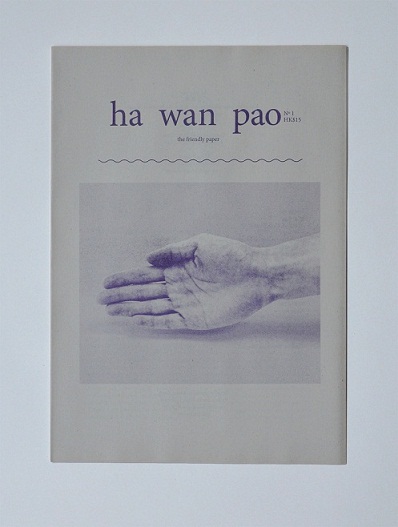Reviews & Articles
Anna Gleeson & Ha Wan Pao
John BATTEN
at 10:54am on 17th December 2012

(原文以英文發表,評論Anna Gleeson的作品。)
The modest magazine Ha Wan Pao attracted me due to its understated design, unpretentious content and its simple credo of being “a monthly paper about people who make beautiful things.” It is “created”, rather than just published by Anna Gleeson.
Australian Gleeson, 34 years old, studied creative media, including filmmaking, and has lived in Hong Kong for three years after previous stints in Japan and the U.S.A. Her art and design practice includes the publication of Ha Wan Pao, a loose-leaf 24-page magazine, printed on a Risograph RP3700 machine by the Ink’chacha Print Collective – a production that promotes and feels like a community effort. Taking its title from an old name for Wan Chai in which it was originally conceived, Ha Wan Pao is inspired by Yanesan, a similar community magazine promoting local artisans, crafts and businesses in the inner Tokyo districts of Yanegi, Nezu and Sendagi.
The magazine runs interviews conducted by Gleeson and a contributor, Furze Chan. Gleeson had seen Furze’s own artwork and had thought “she would probably be a friend, if I knew her.” They did meet, became friends and Furze now provides photography for the magazine (see front cover on Ha Wan Pao No 1, illustrated), a monthly interview and whose brother gives enigmatic “language advice.”
The magazine celebrates creativity in all guises. Particularly informative are interviews with a range of people about their work and the tools they use. Veterinary surgeon Colt Ma explains that an otoscope is a “device that checks on the teeth condition of small animals” and that “his own hands are crucial for veterinary diagnosis”, including “for palpation” by which “the state of organs can all be ‘felt’.” Cross-referencing and subtle links within and between articles runs through the magazine; the veterinarian’s open hand features on the magazine cover.
Gleeson starts designing the magazine from its centerfold spread of images and then includes other interviews and layout from this central focus. There is design balance and harmony and due to the predominantly single-colour printing and raw feel of newsprint, the magazine relies on this purity to give the production strength. Ha Wan Pao has no glossy photography or advertising, save for an almost humble listing of each interviewee’s contact details.
Modeller Dennis Chan converts existing bus models into custom orders for clients, and has a centerfold of twelve photographs of his work tools and a finished model. Artist Sarah Lai explains her preparations for painting, using her favourite but difficult to buy ‘Artrend’ brand paint brushes and that her “brush washer” tin container has “been with her for many years (and) I clean it once in a while.” A photograph of this paint-mottled container is the centerfold for Issue No 2. The registration of the printing is not exact in these spreads, creating a beautiful ghostly skewed feel and both newsprint centrefold spreads appear as art-like print objects. Indeed, only a limited quantity of Ha Wan Pao is printed and available from independent bookshops.
See: www.hawanpao.blogspot.com
A version of this review was published in the South China Morning Post on 11 November 2012.
|
|
|
|
|
|
